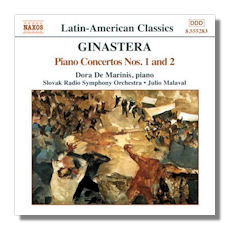
The Internet's Premier Classical Music Source
Related Links
- Ginastera Reviews
- Latest Reviews
- More Reviews
-
By Composer
-
Collections
DVD & Blu-ray
Books
Concert Reviews
Articles/Interviews
Software
Audio
Search Amazon
Recommended Links
Site News
 CD Review
CD Review
Alberto Ginastera

Piano Concertos
- Piano Concerto #1, Op. 28 (1961)
- Piano Concerto #2, Op. 39 (1972)
Dora De Marinis, piano
Slovak Radio Symphony Orchestra/Julio Malaval
Naxos 8.555283
These are atonal works, but the listener should not think of Boulez or Stockhausen, or of generally difficult expressive language. Instead, the music here is more akin spiritually to the style of Hans Werner Henze in his 1967 Piano Concerto #2. In other words, these are sort of populist attempts within the atonal realm. They are rhythmically attractive and colorfully orchestrated, and the piano writing, as is usual with Ginastera, is imaginative in its almost constant sense of dramatic tension. The second movement Scherzo of the 1961 First, for example, is fraught with all kinds of subtle conflicts, and the dark Bartókian third movement seems on the verge of eruption throughout.
The finale is also very Bartókian, recalling some of the savage music from the last movement of his 1927 First. Without doubt, this is rhythmically the most interesting and colorful movement in the concerto, coming on like a frenzy of drive and percussive sounds. It also is the least atonal-sounding movement and will likely appeal even to those of fairly conservative tastes. The Second, from 1972, is perhaps a bit deeper. Its long first movement derives its thematic material from a seven-note chord in the Beethoven 9th Symphony's finale and one formed by Ginastera from the remaining five notes that complete the tone row. There are thirty-two variations on this idea, most quite short and colorful.
The other four movements include a brilliant Scherzo for the left hand. The middle panel, the second longest, is an eerie and compelling movement that won't appeal to most listeners on first hearing, but will bear fruit to the patient on subsequent auditions. Once again the finale presents the most colorful and rhythmically appealing music in the work, this time carrying vague suggestions of the finale of Chopin's Second Piano Sonata, in its blurred, eerie piano sonorities.
Dora De Marinis is certainly compelling in both these works, even if her tempos in faster sections might have been a bit swifter and more urgent. Julio Malaval and the Slovak Radio Symphony provide excellent support and Naxos affords them all fine sound. If you like the repertory, you'll find these of great appeal.
Copyright © 2001, Robert Cummings




















